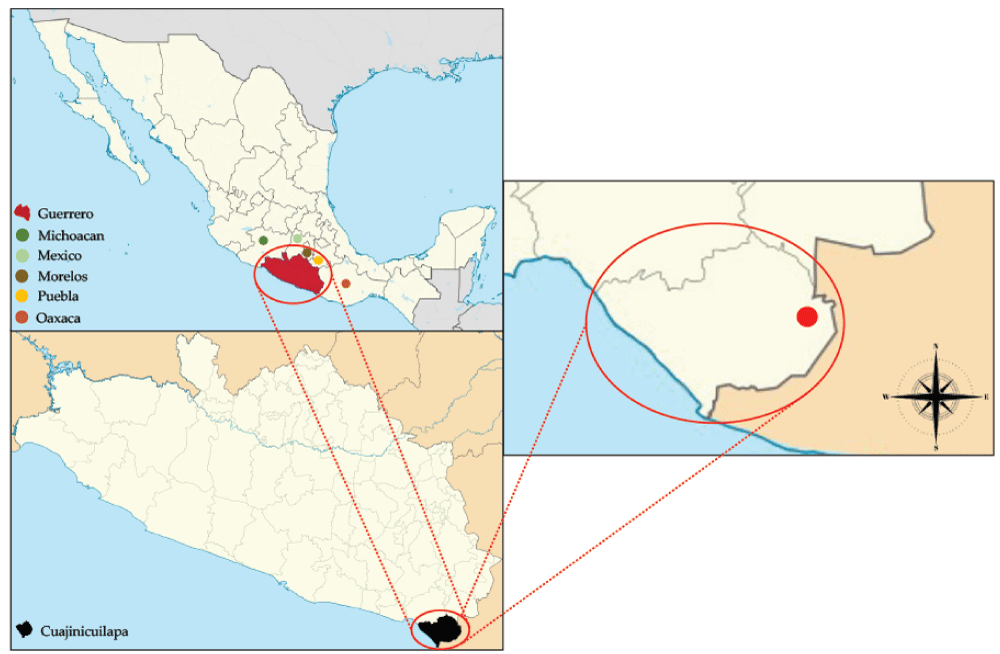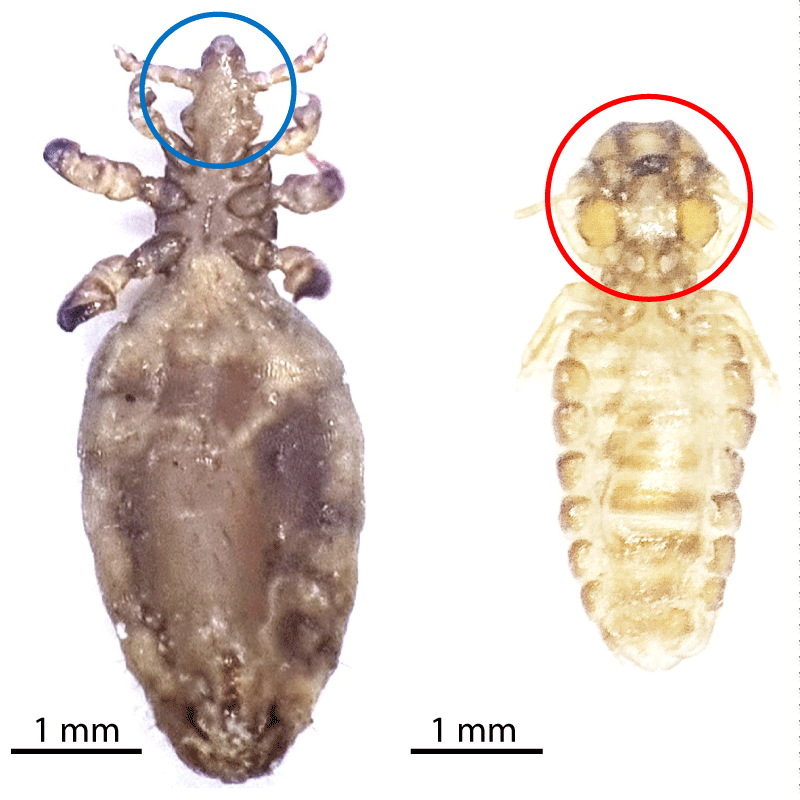Global Journal of Zoology
First record of Damalinia caprae (Gurlt, 1843) and Linognathus africanus (Kelogg and Paine, 1911) (Insecta: Phthiraptera) in small ruminants from Cuajinicuilapa, Guerrero, Mexico
Yaleidi Herrera-Rojas1, Gabriela Alvarado-Rodríguez2, Citlali Estefania Sollano-Mendieta1, Mario Antonio Mendoza-Nuñez1 and Vicente Homero González-Álvarez1*
2Doctoral Student in Animal Production and Health, University of the Sea, Puerto Escondido, Oaxaca, Mexico
Cite this as
Herrera-Rojas Y, Alvarado-Rodríguez G, Sollano-Mendieta CE, Mendoza-Nuñez MA, González-Álvarez VH (2024) First record of Damalinia caprae (Gurlt, 1843) and Linognathus africanus (Kelogg and Paine, 1911) (Insecta: Phthiraptera) in small ruminants from Cuajinicuilapa, Guerrero, Mexico. Glob J Zool 9(1): 001-004. DOI: 10.17352/gjz.000029Copyright
© 2024 Herrera-Rojas Y, et al. This is an open-access article distributed under the terms of the Creative Commons Attribution License, which permits unrestricted use, distribution, and reproduction in any medium, provided the original author and source are credited.This study reports for the first time the lice species infesting small ruminants of three communities of Cuajinicuilapa, Guerrero, Mexico. The lice were manually collected from sheep and goats, deposited in vials containing 70% alcohol, and transported to the Parasitology Laboratory at the Facultad de Medicina Veterinaria y Zootecnia N° 2. For identification, the specimens were cleared in potassium hydroxide (KOH) at 10%, dried, and mounted on slides. A total of 789 lice were collected from goats and sheep. Two lice species, D. caprae and L. africanus were identified, making D. caprae the most prevalent. No other species were identified parasitizing the sampled animals. It is suggested to do more research to determine prevalence, incidence, and affections in the productive and reproductive parameters; as well as, to determine the possible role of the identified lice in the transmission of microorganisms with medical and veterinary importance.
Introduction
Lice are insects belonging to the order Phthiraptera and are a specialized and diverse group of parasitic insects of birds and mammals [1]. The lice in the suborders Amblycera, Ischnocera, and Rhyncophthirina (chewing lice) can be found on both mammals and birds, while those in the suborder Anoplura (sucking lice) can be found only on mammalian hosts [2]. Goats and sheep are infested by chewing and sucking lice, of the genera Damalinia (Mjoberg, 1910) and Linognathus (Enderlein, 1905) [3 ]. Biting lice infestations in goats, are caused by D. caprae (Gurlt, 1843), D. crassipes (Gervais, 1847), and D. limbatus (Gervais, 1844), in sheep by Damalinia ovis (Linné, 1758) [4,5]. Sucking lice infestations in goats are caused by L. africanus (Kelogg and Paine, 1911) and L. stenopis (Burmeister, 1838); while in sheep, by L. ovillus (Numann, 1907) and L. pedalis (Osborn, 1896) [4,5]. However, a great gap of knowledge about the diversity of Phthiraptera still around the world, so the first step is to know the local diversity [6].
Sánchez-Montes, et al. [7-9], reported several species of lice in Mexico parasitizing a diverse variety of mammals. The presence of the lice D. caprae, L. africanus, and L. stenopsis has been previously reported by Lozoya-Saldaña, et al. [10], and the species D. caprae and L. africanus by Gonzalez-Álvarez [11], in the north-central part of the country. According to the Agroalimentary and Fisheries Information Service of Mexico [12], of the 32 states that make up the national territory, the state of Guerrero ranks 6th and 17th in goat and sheep production, respectively. Furthermore, the sanitary situation of ectoparasites affecting both species is not known as well, and, as reviewed by Guzmán-Torres and Cano-Santana [6], Guerrero State does not have reports in the scientific literature, about parasites of the order Phthiraptera affecting the mentioned domestic species. It is known that mammals can harbor more than one species of louse [2], for that reason and due to the presence of sheep and goats and the climate characteristics of the region we hypothesized that lice are present. In this work, we conducted research to investigate the lice species infesting small ruminants of three communities of Cuajinicuilapa, Guerrero, Mexico.
Material and methods
According to the description of Thrusfield, et al. [13], a cross-sectional convenience study was employed. The animal population of the area is unknown, for that reason, a minimum of thirty animals sampled was established as described by Louangrath [14].
Three locations: San Nicolás, Montecillos, and El Jícaro, of the municipality of Cuajinicuilapa were visited for sampling (Figure 1). Cuajinicuilapa is in the southwest of a region known as “The Costa Chica”, between the coordinates: 98°43’23” - 98°20’58” west longitude and 16°18’57” - 16°35’38” latitude north. The region borders to the north with the municipalities of Azoyú and Ometepec, to the east with the municipality of Ometepec and the state of Oaxaca, to the south with the state of Oaxaca and the Pacific Ocean, and to the west with the Pacific Ocean and the municipality of Oaxaca. The area has an altitude between 0 and 200 meters above sea level. The precipitation ranges between 1,100 mm - 1,300 mm, with a warm sub-humid climate with summer rains, with a maximum temperature of 34 °C from April to May [15].
In October 2020, nine herds were visited. After written consent from the animal owner, the goats were held under veterinary supervision, for the purpose of performing the visual inspection for the lice collection, not chemical contention used for animal restriction. The samples were collected from all the animals present in the barnyards. The proper animal handling was done as recommended in LFSA [15] and GCULA [16]. The lice were randomly collected from sheep and goats. All the observed specimens were collected manually, deposited in properly labeled vials containing 70% alcohol, and translated to the Parasitology Laboratory at the Facultad de Medicina Veterinaria y Zootecnia N° 2 - Universidad Autónoma de Guerrero. To clear the specimens, these were rinsed in potassium hydroxide (KOH) at 10%, dried, and mounted on slides. For identification, stereoscopic microscopy (Labomed Luxeo 4Z), and the keys of Price and Graham [17] were employed. Finally, the specimens were kept in the collection of the University.
Results
A total of 130 animals, 22 sheep and 108 goats were inspected for the presence of lice, all the sampled animals were positive of at least one specimen and therefore, the total of the visited farms were also positive. Two lice species were identified parasitizing the animals sampled. In total, 789 lice were collected. According to the keys of Price and Graham [18], the specimens were identified as D. caprae (n = 597) and L. africanus (n = 192). No other species, especially those that specifically parasitize sheep (D. ovis, L. ovillus, and L. pedalis), were found. L. africanus, the African blue louse (Figure 2a) shows as the main characteristic is its greatly expanded post-antennal lateral margins on the head, in addition to five-segmented antennae, and a very slender thoracic sternal plate. The goat-biting louse B. caprae (Figure 2b) has a bluntly rounded head with prominent mandibles on the underside, and its thorax is narrower than the head. The head and thorax are brownish, with a yellowish abdomen and brown crossbands, and a truncated anterior margin of the head .
The flocks are composed of mixed goats and sheep of mixed breeds, subjected to extensive rangeland grazing, with poor husbandry conditions. The farmers’ information does not administer adequate management for endo and ectoparasites control, and it is unknown if endoparasite infestation coexists. None of the goats have had skin problems. Studies to detect the presence of ectoparasites, including mites, fleas, or ticks have not been conducted. Poor bodily condition was observed in several animals of the herd; however, it is not known if it is due to the poor conditions of the grazing area, deficiency of vitamins, or some other factor that could be reducing the weight gain.
Discussion
This study reports for the first time the lice species of goat and sheep in Guerrero State. Several reports around the world [19-24], have documented the presence of D. ovis and L. africanus parasitizing goats and sheep. The presence of chewing and sucking lice as mixed infestations is very common. However, it is important to highlight that the infestation of sheep by D. caprae and L. africanus is due to the coexistence of both ruminant species [25].
Clayton, et al. [26] mention that, if lice are present in small numbers may not have negative effects on their hosts; however, according to Bates [3] in large numbers, and due to the constant skin irritation consequently leads to scratching, rubbing, and licking causing stress. On the other hand, Mellado [27] and Galloway [28] reported that the derivate restlessness causes a decrease in the production (gain weight, milk, and wool) and reproduction parameters, associated with anemia [29,30], as well as birth weight reduction in newborns [31]. Ectoparasite infestation will always be a major challenge in goat and sheep production units [32]. Finally, the mechanical action of chewing lice can be the entry route for various pathogenic bacteria and tapeworms [33]; while biting lice are of concern due to their incrimination in the transmission of some pathogens of veterinary and public health during blood-feeding [34-40].
Conclusion
This is the first scientific record of the lice species parasitizing goats and sheep from Guerrero State. It is suggested to carry out more research on the diversity and prevalence of lice that affect sheep and goats in the different regions of the state. It is necessary to characterize the type of management and evaluate the damage to health and production. In addition, to determine the possible participation of these insects as carriers and possible transmitters of pathogens of interest in public and veterinary health. Finally, set control programs and elimination of this type of ectoparasites.
The authors thank the animal owners for their willingness to carry out sampling.
- Light JE, Smith VS, Allen JM, Durden LA, Reed DL. Evolutionary history of mammalian sucking lice (Phthiraptera: Anoplura). BMC Evol Biol. 2010 Sep 22;10:292. doi: 10.1186/1471-2148-10-292. PMID: 20860811; PMCID: PMC2949877.
- Durden LA. Lice (Phthiraptera), In Medical and Veterinary Entomology, Eds; Mullen GR and Durden LA, Academic Press, Cambridge, Massachusetts. US. 2019; 79-106.
- Bates P. Lice (Phthiraptera), In External Parasites of Small Ruminants: A Practical Guide to Their Prevention and Control, CABI. 2012; 63-73.
- Al-Farwachi MA, Al-Mola ED, Al-Obaidi WA. The variation in the effect of lice infestation between goats and sheep in Mosul area. Iraqi Journal of Veterinary Sciences. 2006; 20(2): 203-210.
- Underwood WJ, Blauwiekel R, Delano ML, Gillesby R, Mischler SA, Schoell A. Biology and diseases of ruminants (sheep, goats, and cattle), In Laboratory Animal Medicine, Ed; Fox JG, Academic Press Elsevier, San Diego, US. 2015; 623-694.
- Guzmán-Torres M, Cano-Santana Z. Update of the list of lice (Insecta: Phthiraptera) of Mexico: distribution, richness, degree of specificity and human pediculosis. Mexican Biodiversity Magazine. 2021; 92: e923800.
- Sánchez-Montes S, Guzmán-Cornejo C, León-Paniagua L, Rivas G. A checklist of sucking lice (Insecta: Phthiraptera: Anoplura) associated with Mexican wild mammals, including geographical records and a host-parasite list. Zootaxa. 2013;3722:183-203. doi: 10.11646/zootaxa.3722.2.4. PMID: 26171522.
- Sánchez-Montes S, Guzmán-Cornejo C, Ramírez-Corona F, León-Paniagua L. Anoplurans (Insecta: Psocodea: Anoplura) associated with rodents distributed in the neotropical region of Mexico. Mexican Biodiversity Magazine. 2016; 87(2): 427-435.
- SÁnchez-Montes S, Colunga-Salas P, Álvarez-Castillo L, GuzmÁn-Cornejo C, Montiel-Parra G. Chewing lice (Insecta: Phthiraptera) associated with vertebrates in Mexico. Zootaxa. 2018 Jan 15;4372(1):1-109. doi: 10.11646/zootaxa.4372.1.1. PMID: 29689830.
- Lozoya-Saldaña A, Quinones-Luna S, Aguirre-Uribe LA, Guerrero-Rodríguez E. Distribution and abundance of malophagous and anoplurous lice of sheep and goats in the Saltillo region, Coahuila, México. Folia Entomológica Mexicana. 1986; 69: 117-125.
- González-Álvarez VH. Presence of two lice species (Insecta: Phthiraptera) in a goat (Capra hircus) from La Comarca Lagunera, Mexico: a case report. International Journal for Research in Applied Sciences and Biotechnology. 2020; 7: 152-155.
- SIAP [Sistema de Información Agroalimentaria y Pesquera] 2022. https://nube.siap.gob.mx/poblacion_ganadera/. Accessed: 11 August 2023.
- Thrusfield M, Christley R, Brown H, Diggle PJ, French N, Howe K, Kelly L, O’Connor A, Sargeant J, Wood H. Veterinary Epidemiology, Fourth Edition, John Wiley & Sons Ltd. New Jersey, US. 2018; 270-295.
- Louangrath PI.Minimum sample size method based on survey scales. International Journal of Social Research Methodology. 2017; 3(3): 44-52.
- INEGI [Instituto Nacional de Estadística y Geografía]. 2010. https://www.inegi.org.mx/contenidos/app/mexicocifras/datos_geograficos/12/12023.pdf. Accessed: 01 August 2022.
- LFSA [Ley Federal de Sanidad Animal] 2018. https://www.diputados.gob.mx/LeyesBiblio/pdf/LFSA.pdf. Accessed at: 01 December 2019.
- GCULA [Guide for the Care and Use of Laboratory Animals]. Ed; National Research Council (US) Committee for the Update of the Guide for the Care and Use of Laboratory Animals, 8th edition, National Academies Press, Washington DC. 2011; 11-40.
- Price MA, Graham OH. Chewing and sucking lice as parasites of mammals and birds. USDA. Technical bulletin 1849: Washington, DC. 1997; 60-181.
- Disasa DD. Lice infestations in sheep and goats in Kombolcha district, east Hararghe zone, Oromia regional state, Ethiopia. Veterinary Medicine International. 2020: 8889755.
- Israel Y, Abera T, Wakayo BU. Epidemiological study on ectoparasite infestation of small ruminants in Sodo Zuria District, Southern Ethiopia. Journal of Veterinary Medicine & Health. 2015; 7(4): 140-144.
- Kantiba W, Yigezu G, Fekede G, Dejene D. Lice Infestation in Sheep and Goats in and around Dembi dolo Town: Associated Risk Factors. Global Scientific Journal. 2020; 8(10): 2132-2139.
- Seid M, Zeryehun T, Kemal J, Tilahun B. Ectoparasites of small ruminants in and around Kombolcha, northeastern Ethiopia. Ethiopian Veterinary Journal. 2018; 22(2): 81-93.
- Urgessa T, Gemeda J, Amale MB, Dejene D, Bedore B. Lice infestation in small ruminants in Nono District, west Showa Zone, Oromia Regional State. European Journal of Applied Sciences. 2020; 12(4): 149-152.
- Kakabwa SR, Amin OM, Polus NN, Mawlood NA. A survey on the prevalence of some ectoparasite species infesting sheep and goats in Kalar district, Kurdistan region, Iraq. ZANCO Journal of Pure and Applied Science. 2021; 33(1): 68-76.
- Syamsul VS, Okene IA, Yahya SNC, Hamdan RH, Lee SH, Tan LP. Prevalence of Ectoparasitism on Small Ruminants in Kelantan, Malaysia. Trop Life Sci Res. 2020 Apr;31(1):45-56. doi: 10.21315/tlsr2020.31.1.3. Epub 2020 Apr 7. PMID: 32963710; PMCID: PMC7485529.
- Clayton DH, Adams RJ, Bush SE. Phthiraptera, the chewing lice. In Parasitic diseases of wild birds, Ed; Atkinson CT, Thomas NJ, Hunter DB, Wiley-Blackwell Publishing. Iowa, US. 2009; 513-526.
- Mellado M. Techniques for the reproductive management of goats in rangelands. Tropical and Subtropical Agroecosystems. 2008; 9(1): 47-63.
- Galloway TD. Biodiversity of ectoparasites: lice (Phthiraptera) and fleas (Siphonaptera). In Insect Biodiversity: Science and Society, II, Ed Foottit RG, Adler PH, Wiley-Blackwell Publishing. Iowa, US. 2018; 457-482.
- Iqbal RM, Mir AQ, Waseem R, Beigh SA, Hussain SA, Nabi SU, Malik HU. Effect of lice infestation on hematological parameters in goats. Journal of Entomology and Zoology Studies. 2018; 6(1): 172-174.
- Tongjura JDC, Amuga GA, Ombugadu RJ, Azamu Y, Mafuiya HB. Ectoparasites infesting livestock in three local government areas (LGAs) of Nasarawa State Nigeria. Science World Journal. 2012; 7(1): 15-17.
- Tadie A, Terefe G, Gizaw Y. Hematological profile of sheep experimentally infested with Bovicola ovis. Journal of Veterinary Science & Technology. 2018; 9(3): 536.
- Obi ZC, Anyaegbunam L, Orji M. Ectoparasitosis, a challenge in sheep and goat production in Uli, Anambra State, Nigeria. Internationa Journal of Fauna and Biological Studies. 2014; 1(5): 27-29.
- Benelli G, Caselli A, Di Giuseppe G, Canale A. Control of biting lice, Mallophaga - a review. Acta Trop. 2018 Jan;177:211-219. doi: 10.1016/j.actatropica.2017.05.031. Epub 2017 Jun 3. PMID: 28587840.
- Abdullah HHAM, Amanzougaghene N, Dahmana H, Louni M, Raoult D, Mediannikov O. Multiple vector-borne pathogens of domestic animals in Egypt. PLoS Negl Trop Dis. 2021 Sep 29;15(9):e0009767. doi: 10.1371/journal.pntd.0009767. PMID: 34587171; PMCID: PMC8480906.
- Ballados-González GG, Martínez-Hernández JM, Martínez-Rodríguez PB, Gamboa-Prieto J, González-Guzmán S, Paredes-Cervantes V, Grostieta E, Becker I, Aguilar-Domínguez M, Vieira RFC, Cruz-Romero A, Sánchez-Montes S. Molecular detection of hemotropic Mycoplasma and Bartonella species in lice from sheep and goats of Mexico. Vet Parasitol Reg Stud Reports. 2023 Sep;44:100921. doi: 10.1016/j.vprsr.2023.100921. Epub 2023 Aug 19. PMID: 37652638.
- Hornok S, Hofmann-Lehmann R, de Mera IG, Meli ML, Elek V, Hajtós I, Répási A, Gönczi E, Tánczos B, Farkas R, Lutz H, de la Fuente J. Survey on blood-sucking lice (Phthiraptera: Anoplura) of ruminants and pigs with molecular detection of Anaplasma and Rickettsia spp. Vet Parasitol. 2010 Dec 15;174(3-4):355-8. doi: 10.1016/j.vetpar.2010.09.003. Epub 2010 Sep 15. PMID: 20943320.
- Kumsa B, Socolovschi C, Parola P, Rolain JM, Raoult D. Molecular detection of Acinetobacter species in lice and keds of domestic animals in Oromia Regional State, Ethiopia. PLoS One. 2012;7(12):e52377. doi: 10.1371/journal.pone.0052377. Epub 2012 Dec 17. PMID: 23285015; PMCID: PMC3524130.
- Mullen GR, Durden LA. Medical and Veterinary Entomology. Elsevier Academic Press, London, UK. 2019; 79-104.
- Ouarti B, Mediannikov O, Righi S, Benakhla A, Raoult D, Parola P. Molecular detection of microorganisms in lice collected from farm animals in Northeastern Algeria. Comp Immunol Microbiol Infect Dis. 2021 Feb;74:101569. doi: 10.1016/j.cimid.2020.101569. Epub 2020 Oct 23. PMID: 33181468.
- Seyoum Z, Tadesse T, Addisu A. Ectoparasites Prevalence in Small Ruminants in and around Sekela, Amhara Regional State, Northwest Ethiopia. J Vet Med. 2015;2015:216085. doi: 10.1155/2015/216085. Epub 2015 Apr 5. PMID: 26464950; PMCID: PMC4590867.
Article Alerts
Subscribe to our articles alerts and stay tuned.
 This work is licensed under a Creative Commons Attribution 4.0 International License.
This work is licensed under a Creative Commons Attribution 4.0 International License.




 Save to Mendeley
Save to Mendeley
